Earlier this week we mentioned Emma Prusch Farm Park, in San José, where we attended this year’s Scion Exchange. What I didn’t have a chance to cover was the rest of the park beyond the fruit orchards.
There’s a lot of buzz about ‘Urban Farming’ these days, but Urban Farming is not new. Although she never intended to be, Emma Prusch became an Urban Farmer of sorts. She didn’t take up farming in the City as many do today. Instead, the City of San José grew over the years, and eventually surrounded her family farm.
Emma was born in 1876, to German parents William and Kate Prusch. From the late 19th Century, the Prusch’s farmed in San José, in an area that was once mostly comprised of farms, and orchards, as difficult as that might be to envision today.
It’s doubtful that when William and Kate Prusch were raising their family in the 1870s, that they ever would have expected San José to eventually become the third largest city in California.
Remarkably, through the decades of San José’s development and growth, the farm survived. The old Prusch family farmhouse still stands, now as a park office, and the barns have been recently renovated.
The 47 acre site that is now Emma Prusch Farm Park, was once Emma’s dairy. Having never married, and never had children, in 1962 Emma Prusch deeded the property to the City of San José, and asked that the land be preserved as a working farm and park. In her obituary, recorded in the San Jose Mercury, it was stated that Emma’s wishes were to have “a model farm to remind future generations that their fathers sprang from the land and lived a country life before subdivisions took over the valley“.
Emma originally bequeathed 86.5 acres of land to the City. The State took almost 28 acres when Interstate 280 was constructed behind the farm, and a further 11.3 acres was subsequently converted into a baseball diamond for the Police Athletic League. The remaining 47 acres today though are what is now Emma Prusch Farm Park.
We’re so grateful Emma had the foresight to set this land aside, and surely if she were to walk through the grounds today, she’d be proud of what remains. As much as we’d like to think that farms this size might become a thing of the future, the direction of modern agriculture instead is making farms this size virtually extinct, so this park provides a unique opportunity for children in the inner city to truly experience a working farm, the way it used to be, just as Emma had wished.
I’m sure if Emma Prusch’s parents were to walk through the City today, they’d be astounded at what has grown up around the farm. Malls, freeways, busy streets.
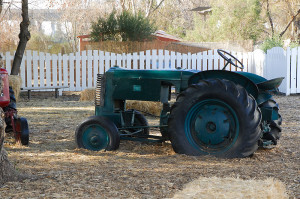
If you look behind the tractor, behind the goat barn roof, you can see a glimpse of the Hwy 101/I-280 freeway interchange in the upper left corner
Fortunately though, Emma’s legacy is that even in the 21st Century this park remains, and affords the public, especially children, an opportunity to enjoy the property she cherished, as they learn about growing vegetables, or raising farm animals, and the farm has lots of animals to interact with.
In the midst of all the city chaos it’s easy to forget for a moment where you are.
When we first arrived at the park, we were greeted by one of many resident park roosters.
Roosters and cities generally don’t mix. Cities that permit the raising of hens, usually have ordinances banishing roosters, because of the noise. Personally I’d rather listen to a rooster crowing than a car alarm, but that’s what I’m used to these days.
San José does permit the raising of up to 6 hens in residential neighborhoods, but like most cities roosters are strictly forbidden. Fortunately for these roosters, the Park is not in a residential district.
In addition to the rooster in the parking lot, we then met this rooster just outside of the building where the scion exchange was being held.
He clearly was rummaging in the soil for bugs and grubs, and quite oblivious to our presence.
Another group of young roosters was gathered in the middle of the International Fruit Orchard among some citrus.
This handsome group was being fed near the children’s playground. It was quite fun to just sit and watch all these birds wandering around.

A rather dapper looking group, including what appears to be a handsome Dominique rooster on the right
As we walked around the park, it became more evident just how special this refuge is in the midst of a metropolis. Watching children playing on the swings, and running around the huge open field in the center of park, they all seemed to take it in stride, many didn’t even seem to notice the birds, like they are just part of everyday life. How wonderful is that? I wonder if they’ll realize when they grow up how special this park was?
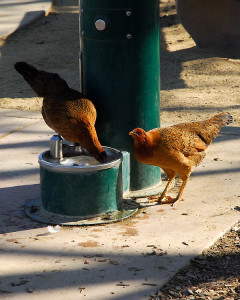
"Pssst...that lady is lookin' at us funny, you'd think she never saw a chicken in a water fountain before"
After we’d collected our scions, we’d heard rumors of goats over in the children’s animal area, so of course, I had to investigate for myself. I’m quite short, maybe nobody would notice if I snuck in for a peek. As we walked through the gate we were first greeted by a small group of rather gregarious Muscovy Ducks.
Just beyond the ducks we found a pot-bellied pig, snoozing in the sun.
I wonder if Rachel knows how lucky she is to live here?
Rachel has a friend Hamlet, but he was sleeping in, so we didn’t get to meet him.
On the fence in front of the goat barn, we found this fine fellow.
A young rooster, presumably a Black Australorp, who doesn’t quite have his spurs yet. He was terribly friendly.
We found the goats, who were out enjoying the sun, and not particularly interested in us at first.
Note to self, do not build a feeder that the goat can stand in! Typical of goats, if they can stand in it, or on it, they will!
We looked over toward the goat barn door, and found Mathilda Milkshake.
Isn’t she adorable with her floppy ears? According to Mathilda’s sign, she’s a Nigerian Dwarf, but those ears suggest she is more Nubian than Nigerian. Nevertheless, she was a very sweet goat.
This is Mrs. Oldie Sour Cream, who decided we might be worth investigating after all.
Then Emma Crema Friday came to see what all the fuss was about.
To the left of the goats is a small pond, which I forgot to take a photograph of because my lens was distracted by this pair of city slicker guinea fowl.
As we made it beyond the goats and guineas we found the Toulouse Geese resting in sun just beyond the pond. I’d forgotten how noisy geese are, not to mention how pushy they can be.
Just beyond the geese, a glimpse of the livestock barn. I suddenly had a serious case of barn envy.
What we couldn’t do with a barn that big! In fact, the barn at Prusch Park is the largest free-standing barn in San José. Local 4H members use the barn to raise their farm animals, including steers, goats, pigs, and sheep, right in the heart of the City.
Dragging ourselves away from the barn, we turned back toward the goats, and suddenly found the geese in hot pursuit of Mr. Curbstone, well…his shoes at least.
The geese were smarter than us. What we didn’t realize at first is we were walking toward the treat dispenser.
For 25 cents, visitors can retrieve a handful of chicken feed.
The birds were clearly all conditioned to come running as soon as one’s hand plunges into a pocket to reach for a quarter. Mr. Curbstone was mobbed before he even had a chance to put the coin in the slot! Don’t get me wrong though, it doesn’t look like anyone here has ever missed a meal.
There is also a dispenser with goat feed in it, and yes, I couldn’t resist feeding the goats. If you ever venture to Prusch Park, be sure to come prepared, and bring along a few extra quarters.
As we walked back by the goats, we found a contented Mathilda dozing in the warm sun with a friend.
As we said goodbye to Rachel on the way toward the gate (she hadn’t moved an inch the entire time we were there), this little fellow came running up to us along Rachel’s fence rail.
If you gave him a pea comb, and super-sized him, he’d look almost exactly like our own rooster, Frodo, feathered feet and all. He was so friendly, you almost wanted to pick him up. If we walked left along the fence, he followed us. We turned and walked right, he followed us again. No doubt hoping that one of us had at least an extra quarter hiding in a pocket somewhere.
As much fun as we had going to the Scion Exchange that morning, I think I had more fun hanging out with our new friends. I highly recommend a visit if you’re in the neighborhood, it’s an excellent place to bring children of all ages, and there are lots of picnic facilities within the park.
If you go though, don’t forget to look up occasionally, you never know who might be perched on a roof above you.
The park offers a number of educational programs for children, and hosts a summer camp from May through August where children can tend the vegetable gardens, and learn to care for the animals. For more information, see here.
Thanks to Emma Prusch this wonderful piece of South Bay farming history has escaped further development, and provides a glimpse of San José’s farming past, just as she hoped. We intend to return soon, as we didn’t get a chance on this visit, to see what’s growing in Emma’s Heirloom Kitchen Garden…
…and of course, we’ll be sure to stop back for another visit with the farm’s animals too.
———–
Emma Prusch Farm Park is located at 647 S. King Road, San José, Ca 95116. The park is open 8am-sunset Tues-Sun. Closed Mondays.













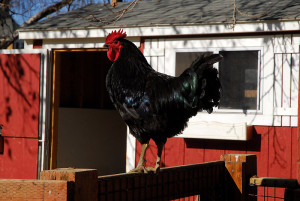




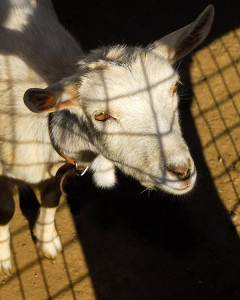





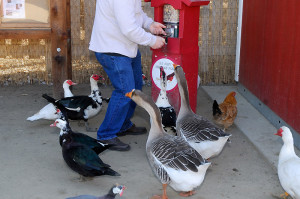
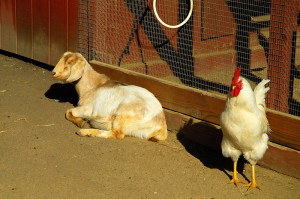
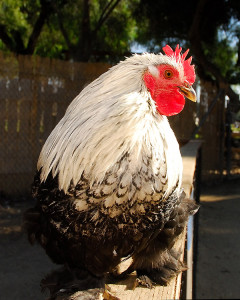












What a wonderful place…I can’t believe it is in a city…seems like the farms I remember in Indiana when I was growing up…of course I was a city girl moved to the rural IN snow belt and then to the snow belt of suburban central NY…but I was a Camp Fire Girl and was in 4H. No animals but I could cook and do a bit of sewing…bird watching, camping…those were the days…thx Emma for preserving this wonderful farm!!!
I really love that the City allows the 4H groups to use this farm. I’m sure that’s something Emma would love, encouraging children, and teaching them, when they otherwise might not have the opportunity, or the resources to do so. Some of my fondest memories as a child were being on farms, and feel that in a perfect world, every child should have the opportunity for such an experience 🙂
Loved seeing all the farm animals! What a wonderful thing Emma did, even though she may not have realized it at the time. So nice that this exists in the city. I hope every child in the city has a chance to visit this farm at some time.
It’s clear that Emma’s intent was to preserve this for future generations, and I’m sure she saw a startling amount of change around her farm in her lifetime. However, I’m not sure even she could have appreciated just how unique her farm would become, and how important it could be as a educational resource for the City’s children. Definitely a heroine in my book!
I loved the tour–what an incredible resource. Are you thinking of getting goats? On my island in Maine where I run the invasive plant removal program, we have adopted two Nigerian dwarf goats to eat the invasive plants (they love native poison ivy too). I have spent a lot of time with them, and they are quite lovable.
Shhhhh…don’t tell anyone, but Mr. CV reserved two Nigerian Dwarf doelings before Christmas that will be born end of Feb-early Mar. Oh wait, I guess that means the goat’s out of the bag 😉 Of course, we can’t control what the does give birth to, but we’re keeping our fingers crossed! Will post more soon about the goats-to-be!
What an amazing gift to leave for so many people. Thanks for sharing your pictures and your experiences at the farm. Next time I’m in the San Jose area I think I will see if I can get my wife to overcome her fear of birds so we can explore the farm ourselves.
When I was looking into Prusch Park’s history, it was largest deed of land ever given to the City. The birds were fantastically sweet, and very mellow…well, except for the Toulouse geese. So long as you bring a few quarters, I think she’ll be fine 😛
What a wonderful place! So inspiring to get back to the basics of farming and no matter where you are. Thanks so much for sharing this great little treasure, will be sure to look it up when I am down that way later this year! Cheers Julia
Oh, I hope you have a chance to go Julia. Maybe bring a picnic if the weather is nice. It’s a really peaceful place to spend a few hours amidst the hubbub of the city. 🙂
Hi Clare – What a great gift Emma left, especially marvellous for families with kids to explore and learn about farming. I Just read your comment about the goats!! Can’t wait to see your new babies!
Emma really did have big heart, and excellent foresight. I’m sure the rate of growth she saw around the farm in her lifetime worried her, and rightfully so. I shared a newspaper photograph of her on Facebook from the 1960’s and she’s standing forward of that large barn, surrounded by fields. Today, the farm is surrounded by freeways.
I can’t wait for goats! They were a complete surprise (I expected it would be another year). We’re off to meet the sire and dam today! 🙂
Thanks for sharing this story, Clare! It sounds so similar to my great-grandparents’ story. They had a vegetable farm/orchard in Michigan–now smack-dab in the middle of Lansing! All that remains are the street names dedicated to family members. I’m glad we have photos of the farm, though, and a good portion of the land went to a hospital and clinic. Thanks for this wonderful tour!
Glad you enjoyed the tour. It is amazing how much the landscape changes in a relatively short space of time, isn’t it?
This is truly a refuge and a treat for those who visit. I am often amazed at how there are those who were so thoughtful. These are the places that teach the next generation and the next and so forth.
I’m glad the City has chosen to preserve what remains of Emma’s land. I hope it can continue on for many more years to come.
I like how friendly all the chickens are, I’ve never seen that before. I’ve always thought of them as somewhat oblivious to humans but I guess it depends on their circumstances. So nice to see a farm and animals in the city, so often city kids never see this kind of thing and are so far removed from where their food comes from.
I agree, I’ve never seen so many roosters all getting along. It makes me wonder what Siegfried and Frodo’s problem was! 😉
Love City Farms…peace in the midst of all that chaos…for me anyway. That place sounds absolutely wonderful. Cute lot of animals too…especially the chickens.
What an absolute charming, clean and friendly place – The roosters are so beautiful and I love Rachel the potbelly 🙂
Thank you for this – it is a joy to see farms that are still so active.
Your narrative (and knowledge of farm breeds) made it all very enjoyable – I felt like I was allowed into the petting area despite not having a child with me. So Clare you have a surprise due in March – almost bunnies with those floppy ears. I feel an ahh moment coming on.
I love this! What a great place! Your animal portraits are wonderful as ever.